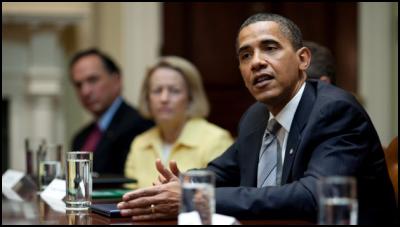Stateside: Goodbye savings and loan?
Goodbye savings and loan?

Click to enlarge
President Obama holds one last discussion with regulators before announcing his proposal (White House Photo, 6/17/09, Pete Souza)
As fate would have it, I was at home this morning and happened to turn to KRON4 in time to see President Obama give his speech in the East Room of the White House about 21st Century Financial Regulatory Reform. (WH release here.)
You probably heard the thud of my jaw hitting the floor when he said:
... we will dismantle the Office of Thrift Supervision and close loopholes that have allowed important institutions to cherry-pick among banking rules. We will offer only one federal banking charter, regulated by a strengthened federal supervisor. We'll raise capital requirements for all depository institutions. Hedge fund advisors will be required to register with the SEC.
Dismantle the Office of Thrift Supervision? Holy cow! The OTS was created in 1989 in response to a number of failures by savings and loan institutions. The Federal Deposit Insurance Corporation lists 796 institutions operating in the Bank Charter Class of OTS-Regulated Savings Association (SA), none of them currently regulated by the FDIC.
The OTS is an office within the Department of the Treasury. According to its Profile page:
The OTS examines each savings association every 12-to-18 months to assess the institution’s safety and soundness, and compliance with consumer protection laws and regulations. In addition, examiners monitor the condition of thrifts through off-site analysis of regularly submitted financial data and regular contact with thrift personnel. OTS examinations and its ongoing supervisory oversight are tailored to the risk profile of each institution.
The OTS receives no appropriations from Congress; the agency’s operating budget is funded by periodic assessments to the thrift industry.
Likewise, the Federal Deposit Insurance Corporation receives no Congressional appropriations; it is funded by insurance premiums paid by participating financial institutions, and by earnings on investments in US Treasury securities. But, unlike the OTS, it is an independent agency of the federal government. According to its website:
The FDIC directly examines and supervises about 5,160 banks and savings banks, more than half of the institutions in the banking system. Banks can be chartered by the states or by the federal government. Banks chartered by states also have the choice of whether to join the Federal Reserve System. The FDIC is the primary federal regulator of banks that are chartered by the states that do not join the Federal Reserve System. In addition, the FDIC is the back-up supervisor for the remaining insured banks and thrift institutions.
The third big player in the supervisory and regulatory framework is the Federal Reserve, which has responsibility for bank holding companies, state-chartered banks that are members of the Federal Reserve System, foreign branches of member banks, edge and agreement corporations through which US banking organizations may conduct international banking activities, state-licensed branches of foreign banks, and the nonbanking activities of foreign banks.
And then there’s the Office of the Comptroller of the Currency, which charters, regulates, and supervises all national banks. It is a bureau in the Treasury. God help us if the OCC is the federal regulator that the Obama administration has in mind for taking over the rest of the banking industry. As the timeline of People and History, produced for the OCC’s 140th anniversary in 2003, so succinctly shows, Comptrollers have had their ups and downs, taking the economy with them:
C. Todd Conover, 1981-1985,
promoted deregulation of national banks.
Robert L.
Clarke, 1985-1992, strengthened risk-based examination
practice to meet nationwide banking crisis.
Eugene A.
Ludwig, 1993-1998, encouraged access to credit and the
growth of bank subsidiaries.
John D. Hawke, Jr.,
1998-Present, integrated technological advances into
supervisory process, and worked to end disparities in
funding of state and national bank supervision.
In 2004, Hawke was replaced by John Dugan, whose agency is the driver referred to in this Yelp consumer review of the OCC: Who fell asleep at the wheel of a big rig wide load? Written in May 2008, the review predates the financial meltdown later that year.
In his March 19, 2009, statement to the Senate Committee on Banking, Housing and Urban Affairs, Dugan suggested the Federal Reserve should be “the one agency with authority and accountability for identifying and addressing ... risks across the financial system.” However, he was also “opposed to removing consumer protection regulation and supervision from prudential supervisors, instead consolidating such authority in a new federal agency.”
Well, I don’t know what to make of the President’s plan. There’s nothing simple about it even without supervisory and regulatory responsibilities being strewn across the federal landscape like Monopoly money at a windy-day picnic. (It’s important to note that there is more than just a semantic difference between the words “office”, “agency” and “bureau” in federalese.)
It’s likely to create a great deal of financial turmoil before anything gets appreciably better. If only because “raising capital requirements for all depository institutions” conceivably means that a lot of small banks will be driven out of the market.


 Martin LeFevre - Meditations: From Symbolic Consciousness To Insight Consciousness
Martin LeFevre - Meditations: From Symbolic Consciousness To Insight Consciousness Binoy Kampmark: Arresting And Killing Greenies - Targeting Climate Change Protests
Binoy Kampmark: Arresting And Killing Greenies - Targeting Climate Change Protests Ian Powell: Welcome Puberty Blockers Report But Beware Derailing Transphobia
Ian Powell: Welcome Puberty Blockers Report But Beware Derailing Transphobia Gordon Campbell: On Why We Can’t Survive Two More Years Of This
Gordon Campbell: On Why We Can’t Survive Two More Years Of This Binoy Kampmark: Join The Army; Travel To Exotic, Distant Lands; And Radicalise
Binoy Kampmark: Join The Army; Travel To Exotic, Distant Lands; And Radicalise Ramzy Baroud: Letters from Gaza – ‘Alhamdulillah. We Are Not Okay’
Ramzy Baroud: Letters from Gaza – ‘Alhamdulillah. We Are Not Okay’